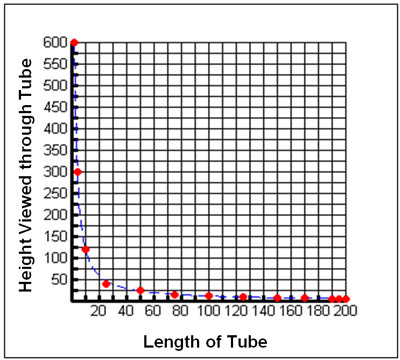

![]() In this investigation, you are going to simulate looking through a paper tube.
In this investigation, you are going to simulate looking through a paper tube.
First, click here to print the Inverse Variation Investigation.
The image below is a screen shot of the Tube Viewer Simulation. Click on the image to open a new window/tab and launch the applet.
After you are finished with the investigation, close the window/tab and...
| Length of Tube (cm) | Height Viewed through Tube (cm) |
| 0 | undefined |
| 2 | 600 |
| 4 | 300 |
| 10 | 120 |
| 25 | 48 |
| 50 | 24 |
| 75 | 16 |
| 100 | 12 |
| 125 | 9 |
| 150 | 8 |
| 170 | 7 |
| 190 | 6 |
| 195 | 6 |
| 200 | 6 |


Inverse Variation is a relationship in which the product of two variables is constant. If xy = k or
y =
numerator k denominator x
k
x
, where k is a non-zero constant, then y varies inversely with x.
An inverse variation is a special type of rational function in which both the x-axis and the y-axis are
asymptotes.
This investigation shows an inverse variation situation. As the length of the tube increased, the height seen through the tube decreased. The equation you found to model the situation was in one of the forms xy = k or y =
numerator k denominator x
k
x.
One science application that is an example of an inverse variation model is Ohm's Law.
Ohm's law states that I = numerator V denominator R V R .
This law can be used to determine the amount of current I, in amps, flowing in the circuit when a voltage V, in volts, is applied to a resistance R, in ohms.
To see a model of how Ohm's Law works and how the equation is derived, visit this site:
![]() Ohm's Law Activity
Ohm's Law Activity
The first page of the site has an explanation and a simulation to work on by trial and error. After you study what works and the equation that models the situation, follow the link to page two where there is another situation.
Now, on your own paper, let's practice using Ohm's Law.
Ohm's law states that I = numerator V denominator R V R .
This law can be used to determine the amount of current I, in amps, flowing in the circuit when a voltage V, in volts, is applied to a resistance R, in ohms. For this problem situation, I = 8.8 amps and V = 110 volts; we need to find R ohms.
8.8 = numerator 110 denominator R 110 R
8.8R = 110
R = numerator 110 denominator 8.8 110 8.8 = 12.5
The heating coils in the curling iron have a resistance of 12.5 ohms.

For this problem situation, R = 12.5 ohms and V = 220 volts; we need to find I amps.
numerator 220 denominator 12.5 220 12.5 = 17.6
The current flow into the curling iron would be 17.6 amps.
